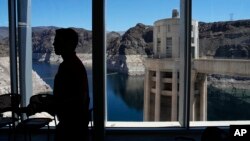Arizona, Nevada and California said Monday they’re willing to cut back on their use of the dwindling Colorado River in exchange for money from the federal government — and to avoid forced cuts as drought threatens the key water supply for the U.S. West.
The $1.2 billion plan, a potential breakthrough in a year-long stalemate, would conserve an additional 3 million acre-feet of water through 2026, when current guidelines for how the river is shared expire. About half the cuts would come by the end of 2024.
That's less than what federal officials said last year would be needed to stave off crisis in the river but still marks a notable step in long and difficult negotiations between the three states.
The 2,334-kilometer river provides water to 40 million people in seven U.S. states, parts of Mexico and more than two dozen Native American tribes. It produces hydropower and supplies water to farms that grow most of the nation's winter vegetables.
In exchange for temporarily using less water, cities, irrigation districts and Native American tribes in the three states will be paid. The federal government plans to spend $1.2 billion, said Lauren Wodarski, a spokesperson to U.S. Senator Catherine Cortez Masto, a Nevada Democrat.
Though adoption of the plan isn't certain, U.S. Bureau of Reclamation Commissioner Camille Touton called it an “important step forward.” She said the bureau will pull back its proposal from last month that could have resulted in sidestepping the existing water priority system to force cuts while it analyzes the three-state plan. The bureau's earlier proposal, if adopted, could have led to a messy legal battle.
"At least they’re still talking. But money helps you keep talking,” said Terry Fulp, former regional director of the U.S. Bureau of Reclamation’s Lower Colorado Basin region. He noted the agreement is a “short-term, three-year deal” and that because the Upper Basin states of Colorado, New Mexico, Utah and Wyoming didn’t face immediate cuts, they were not part of the pact.
The three Lower Basin states are entitled to 7.5 million acre-feet of water altogether from the river. An acre-foot of water is roughly enough to serve two to three U.S. households annually.
California gets the most, based on a century-old water rights priority system. Most of that goes to farmers in the Imperial Irrigation District, though some also goes to smaller water districts and cities across Southern California. Arizona and Nevada have already faced cuts in recent years as key reservoir levels dropped based on prior agreements. But California has been spared.
Under the new proposal, California would give up about 1.6 million acre-feet of water through 2026 — a little more than half of the total. That's roughly the same amount the state first offered six months ago. It wasn't clear why the other states agreed to a deal now when California didn't offer further cuts. Leaders in Arizona and Nevada didn't immediately say how they'd divide the other 1.4 million acre-feet.
The Imperial Irrigation District would account for more than half of California’s cuts. J.B. Hamby, chairman of the Colorado River Board of California, said the district has already taken measures to improve water efficiency and will need to do more. He said the district is working on a pilot summer idling program where farmers would sign up to turn off their water for 60 days for forage crops. During that time of year, yields are already down and more water is required, he said.
Bill Hasencamp, manager of Colorado River resources for the Metropolitan Water District of California, which supplies water to 19 million people in southern California, said the wet winter means the state simply needs less water. His district is planning on leaving 250,000 acre-feet this year in Lake Mead and won’t withdraw it until after 2026.
The district will also turn over to the federal government a program that pays farmers to fallow land that typically nets them about 130,000 acre-feet of water a year, he said.
The Colorado River has been in crisis for years due to a multi-decade drought in the West intensified by climate change, rising demand and overuse. Water levels at key reservoirs dipped to unprecedented lows, though they have rebounded somewhat thanks to heavy precipitation this winter.
In recent years, the federal government has cut some water allocations and offered billions of dollars to pay farmers, cities and others to cut back. But key water officials didn't see those efforts as enough to prevent the system from collapsing.
Michael Cohen, a senior researcher at the Pacific Institute focused on the Colorado River, called the amount of cuts the three states have proposed a “huge, huge lift” and a significant step forward.
“It does buy us a little additional time,” he said. But if more dry years are ahead, “this agreement will not solve that problem.”








